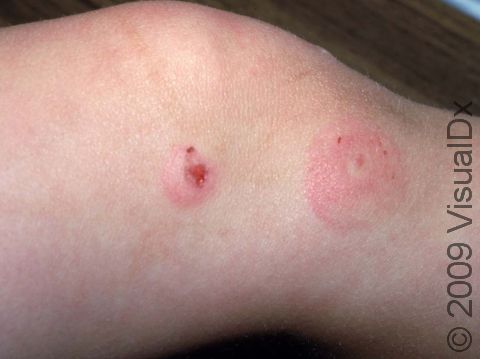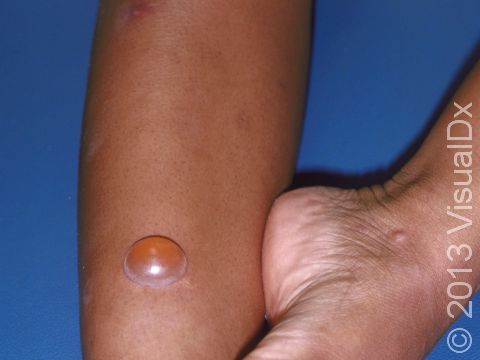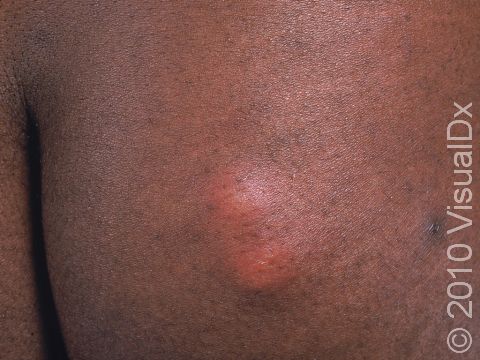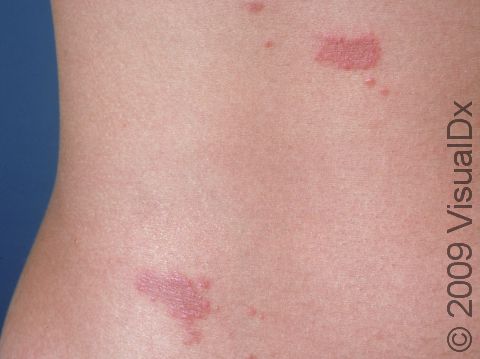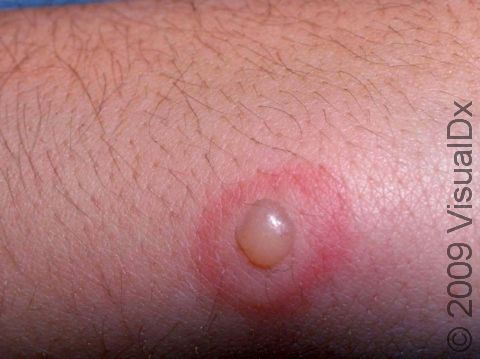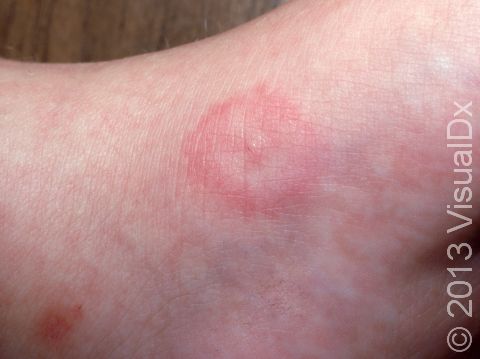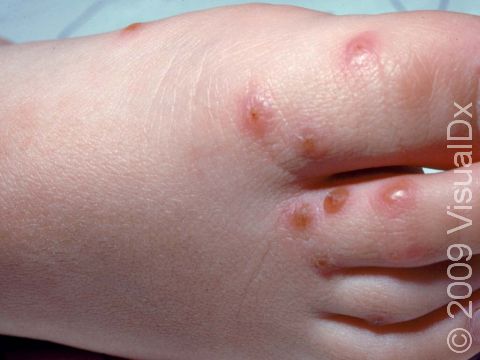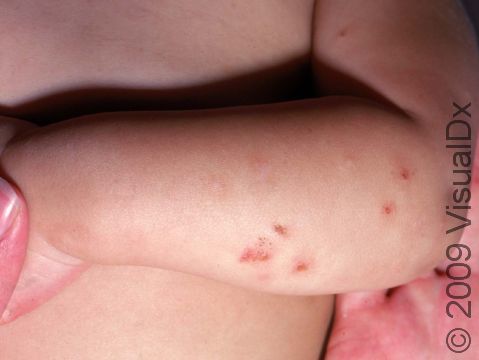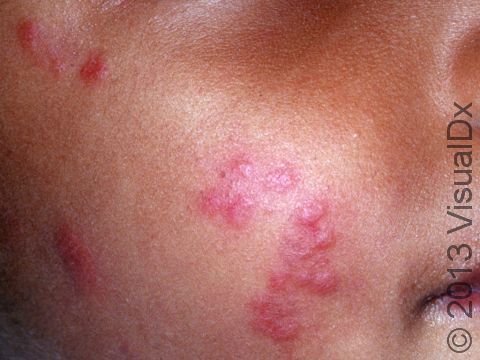Bug Bite or Sting (Pediatric)
Bites or stings from insects (arthropods) are very common. Most reactions are mild, and symptoms are caused by an allergic reaction to either the insect or the irritating substances (toxins) the insect makes and injects along with the bite or sting.
Some people have severe reactions to the stings of:
- Bees
- Wasps
- Hornets
- Yellow jackets
Get medical help immediately for severe stings. The bites of most insects (such as ants, mosquitoes, flies, spiders, ticks, bugs, and mites) do not cause such a severe reaction.
Sometimes, it may be hard to tell which type of insect has caused the skin reactions, as many insect reactions look the same. Flying insects tend to bite or sting uncovered (exposed) skin areas, while bugs such as fleas tend to bite the lower legs and around the waist, often with several bites grouped together.
Some people are far more sensitive to insects and have more severe reactions, so the fact that no one else in your family seems to be affected does not mean that your child has not suffered an insect bite.
Who's At Risk?
Insect bites and stings are a problem in all regions of the world for people of all ages. In the Midwest and East Coast regions of the US, mosquitoes, flying insects, and ticks cause most bites. In drier areas of the Western US, crawling insects are more likely to cause bites.
There is no proven connection to race or sex in terms of how a person reacts to bites. However, some individuals clearly seem more attractive to insects, perhaps related to body heat, odor, or how much carbon dioxide they give off when they breathe.
About 0.5–5% of people living in the US are likely to have severe allergic reactions to stings.
Signs & Symptoms
Insect bites usually appear as small, itchy, red bumps, occasionally with a blister. Very young children may be more prone to developing blisters than older children. Some insects, such as fire ants, can cause a painful and itching raised area containing pus (a pustule).
Flying insects tend to bite exposed areas not covered by clothing, while some bugs (such as fleas) focus on the lower legs. Bedbugs prefer the head and neck area, often biting several times in the same area and leaving a group of lesions.
Common reactions to arthropod stings may include:
- Redness, pain, and swelling
- Severe reactions such as facial swelling, difficulty breathing, and shock
(anaphylaxis) - Fever, hives, and painful joints (although these reactions are not as common)
Very few spiders cause severe reactions. The black widow spider may cause only a mild reaction at the bite site, but pain, stiffness, chills, fever, nausea, and abdominal pain may follow within a few hours. Similarly, the brown recluse spider bite may cause a severe skin reaction after a few hours, with redness, pain, blistering, and ulcers forming, as well as fever, nausea, and fatigue.
Self-Care Guidelines
For stings:
- Bees may leave a stinger behind. Try to gently scrape the stinger off with a blunt object, such as a credit card.
- Wash the wound with soap and water.
- Apply an ice pack or cold water for a few minutes.
- Take acetaminophen (Tylenol®) for pain and an antihistamine (diphenhydramine or
chlorpheniramine) for itching, as needed.
For insect bites:
- Wash with soap and water.
- Apply cool compresses.
- Use antihistamines to relieve itching, and take acetaminophen (Tylenol) for pain.
- Apply 1% hydrocortisone cream to help reduce the itching.
For ticks (still attached):
- Using tweezers, grasp the tick as near the skin as possible and pull firmly
until it releases. - Swab the area with alcohol or wash with soap and water.
- Save the tick for identification, if needed.
- Apply 1% hydrocortisone in case a reaction occurs.
Treatments
Depending on the type of insect bite and how your child reacts to it, your child’s doctor might treat you in a number of ways.
For insect bites:
- Prescription topical corticosteroids
- Muscle relaxants
- Pain medicines
- An antidote against the specific toxin (antivenin)
- Antibiotics
- Sometimes surgery at the affected area, if the insect bite is severe
For stings:
- Antihistamines or corticosteroids
- Epinephrine
- Antihistamines
- Corticosteroids
- Injected (intravenous) fluids and oxygen for shock (anaphylaxis)
- Injectable epinephrine if your child is known to have severe allergic reactions
- Procedures to stimulate the immune system (immunotherapy) to reduce the chance of repeated severe reactions
Visit Urgency
Some insect bites/stings are more dangerous than others. If you suspect your child might have a black widow or brown recluse spider bite, apply ice to the area and seek medical help immediately.
Symptoms of these bites include:
- A deep blue or purple area around the bite, often with a surrounding white
area and a red outer ring - Abdominal pain
- Headache
- Fever
- Fatigue
- Nausea
- Muscle stiffness
If the area of a tick bite becomes red or swollen, or if the affected area spreads outward, seek medical help to check for Lyme disease.
When dealing with stings, watch out for symptoms such as:
- Hives, itching, or swelling in areas beyond the sting site
- Swelling of the lips or throat
- Tightness in the chest or difficulty breathing
- Hoarse voice or tongue swelling
- Dizziness or loss of consciousness
Trusted Links
References
Bolognia, Jean L., ed. Dermatology, pp.405. New York: Mosby, 2003.
Freedberg, Irwin M., ed. Fitzpatrick’s Dermatology in General Medicine. 6th ed. pp.2289, 2291, 2295-2298. New York: McGraw-Hill, 2003.
Last modified on October 10th, 2022 at 8:36 pm

Not sure what to look for?
Try our new Rash and Skin Condition Finder
